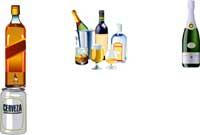Alcoholic beverages: numerous empty calories
The raw material of alcohol-containing beverages is usually a fruit or a citation. The yeast type saccharomyces produces the fermentation of carbohydrates, giving rise to ethanol or ethyl alcohol, but the quantity varies. Cider is the drink with the lowest percentage of alcohol (2-4%), followed by beer (3-6%) and wine (9-12%). From fermentation, a maximum of 16-17 g of ethanol is obtained, so drinks with the highest percentage of alcohol (40-60 g of ethanol/100 ml) are usually obtained from the distillation process.

What happens in the body with this alcohol? The body gets energy per gram of ethanol of 7 kcal. But even though only from the energetic point of view seems a profitable food, alcohol usually generates many imbalances. On the one hand, to obtain this energy, the body needs a lot of vitamin and, not having it, it has to take advantage of what other foods offer; on the other hand, the liver has to make a huge effort. For example, a small forest needs an hour to digest the wine. That is why it is called pure kilocalorie to energy from alcohol, and the hook of those unsustainable days is there, in the absence of vitamins and water.
Although cider, beer and wine have low alcoholic content, we take them in great quantity and, therefore, offer us an appreciable amount of energy. However, it should be noted that these drinks are made from fruits and citrus fruits, so they have some healthy properties. For example, in the case of cider, the tannins called procyanidins stand out, which work as cardiac protectors. Other alcoholic beverages lack nutritional interest and some of the properties mentioned do not have a scientific basis, such as saying that whisky is good for the heart.
In summary, it is best to store alcoholic beverages for special moments. In addition, as they are totally prohibited during pregnancy and lactation, if you are on diet to lose weight, you should not drink alcoholic beverages. Energy from alcoholic beverages will never exceed 10% of daily calories. Therefore, at least the day after the Christmas holidays, it is better to put aside these drinks so that then the surprise is not so big.
The influence of alcohol on the body is conditioned by factors such as sex, weight, fasting intake or accompanied by food, the presence or not of soft drinks, etc. As a curiosity we will say that the Indians, Japanese, Chinese and, in general, the inhabitants of all the countries of the East have less dimanager power, since they have less enzymes for this task in the liver.
Buletina
Bidali zure helbide elektronikoa eta jaso asteroko buletina zure sarrera-ontzian











